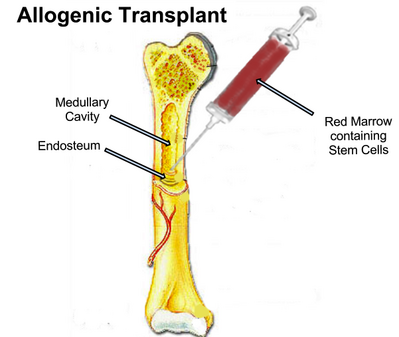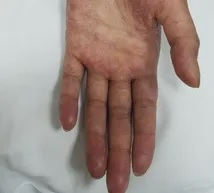Chronic Graft Versus Host Disease: Difference between revisions
No edit summary |
No edit summary |
||
| Line 23: | Line 23: | ||
* GI symptoms usually include diarrhea and abdominal pain, but mucositis, mucosal ulceration, nausea, and vomiting. Liver involvement usually include abnormal liver function tests with elevated bilirubin and alkaline phosphatase levels. | * GI symptoms usually include diarrhea and abdominal pain, but mucositis, mucosal ulceration, nausea, and vomiting. Liver involvement usually include abnormal liver function tests with elevated bilirubin and alkaline phosphatase levels. | ||
Chronic GVHD has a presentation similar to collagen vascular disorders and systemic sclerosis. Death may occur due to recurrent infections (as a complication of immunosuppression).<ref name=":1" /> | Chronic GVHD has a presentation similar to collagen vascular disorders and systemic sclerosis. Death may occur due to recurrent infections (as a complication of immunosuppression).<ref name=":1" /> | ||
Physiotherapy | |||
In put from physiotherapists may occur in the rehabilitation phase. Rehabilitation interventions may be required to manage complications such as reduced cardiopulmonary function, steroid-induced myopathy or bone and joint destruction. | |||
===References=== | ===References=== | ||
[[Category:Autoimmune Disorders]] | [[Category:Autoimmune Disorders]] | ||
[[Category:Conditions]] | [[Category:Conditions]] | ||
Revision as of 02:13, 29 January 2023
Introduction[edit | edit source]
Graft versus host disease (GvHD) is a very common complication of bone marrow transplantations ( also known as allogeneic haematopoietic stem cell transplantation). Anti-rejection drugs have decreased the incidence, however it still occurs regularly.[1]
Pathology[edit | edit source]
Graft versus host disease presents either early/acute (<100 days) or late/chronic (>100 days) post bone marrow transplantation, being a major complication. The skin, gastrointestinal tract (in particular the small bowel), and liver are the organs most often affected.[1]
How is GVHD Diagnosed?[edit | edit source]
A clinical diagnosis is usually made. Typically diagnosis includes the following:
- Immunologically competent cells present in the graft.
- The recipient has transplantation alloantigens appearing foreign to the graft and hence stimulate it antigenically.
- The recipient cannot mount an effective immunologic reaction against the graft, or enough time is allowed for the graft to manifest an immune response.[2]
Treatment[edit | edit source]
Treatment for GVHD is determined by the severity of symptoms and organs involved. Treatment options are based on immunosuppression with corticosteroids being the most commonly used treatment.[2]
What Are the Clinical Manifestations for cGVHD?[edit | edit source]
Acute GVHD typically involves the skin, gastrointestinal tract, and liver. It may involve the lungs, kidneys, eyes, and hematopoietic system. Decreased responsiveness to active immunization may also occur.
- Skin manifestation commonly arise as pruritic or painful maculopapular rash, first involving the palms, soles shoulders, and nape of the neck.
- GI symptoms usually include diarrhea and abdominal pain, but mucositis, mucosal ulceration, nausea, and vomiting. Liver involvement usually include abnormal liver function tests with elevated bilirubin and alkaline phosphatase levels.
Chronic GVHD has a presentation similar to collagen vascular disorders and systemic sclerosis. Death may occur due to recurrent infections (as a complication of immunosuppression).[2]
Physiotherapy
In put from physiotherapists may occur in the rehabilitation phase. Rehabilitation interventions may be required to manage complications such as reduced cardiopulmonary function, steroid-induced myopathy or bone and joint destruction.
References[edit | edit source]
- ↑ 1.0 1.1 Radiopedia Graft versus host disease Available: https://radiopaedia.org/articles/graft-versus-host-disease(accessed 28.1.2023)
- ↑ 2.0 2.1 2.2 Vaillant AA, Modi P, Mohammadi O. Graft versus host disease. InStatPearls [Internet] 2022 Jul 8. StatPearls Publishing.Available:https://www.ncbi.nlm.nih.gov/books/NBK538235/ (accessed 28.1.2023)








